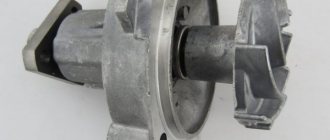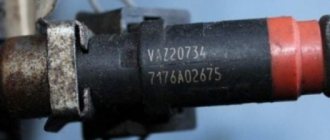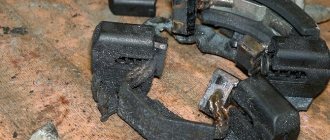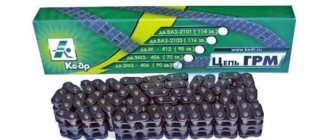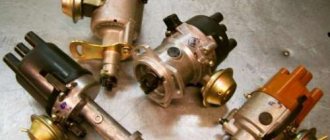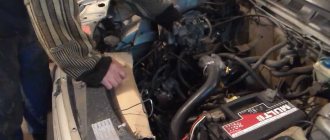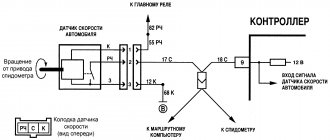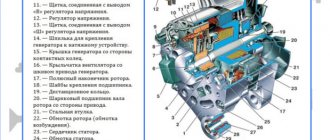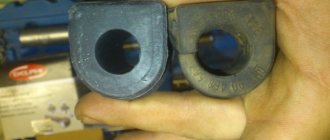Functions and design of the camshaft
The VAZ 2107 camshaft (injector and carburetor) synchronizes the operation of the intake and exhaust valves with the position of the pistons in the engine cylinders. It opens the exhaust valves to release exhaust gases and the intake valves to fill the combustion chambers with an air-fuel mixture. The “seven” uses an engine layout with an overhead camshaft. This reduces the cost of construction and makes the maintenance process easier. The VAZ 2107 camshaft is connected to the engine crankshaft via a chain driven by a sprocket. As the camshaft rotates, the cams located on it press on the rocker and open (close) the valves at the right moment. The camshaft bearing journals rotate in the bearings of the “bed” installed in the engine head. Lubricant from the oil pump is supplied to them through the oil channels, so the condition of the camshaft affects the pressure in the engine lubrication system.
Camshaft faults
The main reason for checking the condition of the VAZ 2107 camshaft is the appearance of a characteristic knocking sound in the head while the engine is running. There may be several reasons:
- wear of camshaft cams;
- wear of camshaft support bearings or bed journals;
- deformation of the part as a result of overheating;
- the appearance of a crack on the support of the part;
- camshaft fracture;
- lack of oil or low pressure in the engine lubrication system;
- clogged oil channels
- low quality oil.
The line of Nuzhdin camshafts for tuning eight-valve VAZ engines of the “Classic” family can be divided into two parts:
• Need camshafts for mechanical pushers of the VAZ “Classic” Need camshafts for hydraulic pushers of the VAZ “Classic”
When installing all camshafts, it is recommended to replace the upper valve spring retainers with modified ones. This achieves an increase in the maximum travel of the springs and a decrease in preload, which is quite unnecessary in the standard configuration. This reduces friction in the timing mechanism (reduces wear and fuel consumption). If necessary, you can increase the maximum kinematic speed by using lightweight valves and alloy spring plates.
Part 1. Technical characteristics of Nuzhdin for mechanical tappets:
Nuzhdin 21213 -…
| serial* | 10.50 | 11.40 | 11.20 | 11.33 | 11.45 | ||
| 2101 | 21213/14 | ||||||
| Valve lifts, mm ___ intake ___ exhaust | 9,5 9,5 | 10,7 9,5 | 10,50 10,50 | 11,40 10,60 | 11,2 11,2 | 11,33 10,90 | 11,45 11,00 |
| Intake valve opening phase, deg. | 256 | 268 | 289 | 283 | 290 | ||
| Exhaust valve opening phase, deg. | 256 | 260 | 289 | 265 | 286 | ||
| Valve overlap height, mm | 0,8 | 0,8 | 1,9 | 1,7 | 2,65 | 2,03 | |
| Base diameter of cams, mm | 30 | 30 | |||||
| Exhaust/intake cam clearance | 0,20 \ 0,15 | ||||||
* — parameters of serial camshafts 2101 and 21213 are given for comparison
• The phases are shown when setting the valve overlap point at TDC of the crankshaft. • After installing the camshaft, the carburetor should be adjusted. It is recommended to install the OZ when detonation occurs. To optimize injection engines, controller calibration is required.
Needs 21213 - 10.50 Mechanical clearance adjustment. Popular "Estonian I". Recommended for tuning cylinder head, for classic 1.5-1.6 liter engines. As a result, together with modification of the cylinder head, an economical universal engine is obtained.
Nuzhdin 21213 - 11.40 “Estonian” (modernized) Mechanical clearance adjustment. A more powerful option, recommended for budget installation in a serial head, without modifications.
Needs 21213 - 11.2 Mechanical clearance adjustment. Power option for boosting speed.
Needs 21213 - 11.33 Mechanical clearance adjustment.
Needs 21213 - 11.45 Mechanical clearance adjustment. Camshaft for speed boost.
Part 2. Technical characteristics of Nizhdin for hydraulic pushers:
| Needs 21214 -… | serial* | 10.90 | 11.50 | |
| 2101 | 21213/14 | |||
| Valve lifts, mm ___ intake ___ exhaust | 9,5 9,5 | 10,7 9,5 | 10,90 9,80 | 11,50 10,50 |
| Intake valve opening phase, deg. | 258 | 251 | ||
| Exhaust valve opening phase, deg. | 256 | 249 | ||
| Valve overlap height, mm | 0,8 | 0,8 | 1,05 | 1,26 |
| Base diameter of cams, mm | 30 | 30 | ||
| Lowering the bed r\v, mm | 0.5 — 0.6 | |||
* — parameters of serial camshafts 2101 and 21213 are given for comparison
• The phases are shown when setting the valve overlap point at TDC of the crankshaft. • Camshafts require an adjustable cam sprocket. • After installing the camshaft, the carburetor should be adjusted. It is recommended to install the OZ when detonation occurs. To optimize injection engines, controller calibration is required.
Need 21213 - 10.90 Camshaft for hydraulic compensators. It is a low camshaft for Niva and Chevrolet Niva cars with a 1.7 liter engine. Adds torque in the range up to 4000 rpm.
Need 21214 - 11.50 Camshaft for hydraulic compensators. It is a universal camshaft for Niva and Chevrolet Niva cars with a 1.7 liter engine. Adds torque in the range up to 6000 rpm. For engines with a volume of 1.9 - 2.0 liters, the camshaft is low-level.
Article written: August 27, 2011 Updated: January 29, 2012 Author of the article, photo-video materials: © Quasar Prohibited without the written permission of the author: reprint of the article in whole or in part, reprint and use of photo-video materials, as well as their modification and editing for further publication on third-party sites.
How to remove the camshaft of a VAZ 2107
Replacing the VAZ 2107 camshaft begins with its dismantling. To do this you need to do the following:
- place the car on a level surface;
- wait until the engine cools down;
- clean the engine head cover from dirt;
- remove the air filter, disconnect the cable, tip and rod of the throttle valve drive, remove
- fuel hose from the bracket (on a car with a carburetor engine);
- disconnect the air supply hose, vacuum hose and remove the fuel filter from the bracket (on a car with an injection engine);
- Using a 10mm wrench, unscrew the nuts securing the cylinder head cover;
- remove the washers from the cylinder head cover;
- release the wiring harness, crankcase exhaust and power steering hoses, and the headlight hydraulic adjustment tube from the bracket mounting;
- remove the cylinder head cover from the studs;
- remove the gasket;
- set the camshaft position so that it corresponds to the end of the compression stroke in the fourth cylinder;
- Use a chisel to bend the petal of the camshaft sprocket lock washer;
- engage first gear to prevent crankshaft rotation;
- Using a 17mm wrench, unscrew the camshaft sprocket mounting bolt;
- remove the bolt together with the lock washer;
- Using a 10mm wrench, unscrew the two nuts securing the chain tensioner;
- remove the tensioner;
- tie the chain to the camshaft sprocket with wire so that it does not jump off;
- remove the sprocket and chain, move it forward;
- Using a 13mm wrench, unscrew the nuts securing the camshaft bearing housing (this must be done evenly so that the housing does not “lead”);
- remove the bed along with the camshaft from the studs;
- use a 10 mm wrench to unscrew the two nuts securing the thrust flange;
- remove the flange from the groove in the front journal of the camshaft;
- pull the camshaft out of the bed (bearing housing).
If signs of wear are visible on the camshaft journals or cams, the camshaft needs to be replaced. It also needs to be changed if cracks or deformation appear. Sometimes the cause of a knocking noise may be wear on the camshaft housing bearings. In this case, it is enough to replace only the bed.
Installation of camshaft VAZ 2107
The cylinder head camshaft is installed in the reverse order of removal. Before installing the part into the housing, it is necessary to lubricate the support journals with engine oil. When assembling, you should pay attention to two important points:
- correspondence of the marks on the camshaft and on the sprockets of its drive;
- tightening torque of the camshaft housing nuts.
First, you need to properly tighten the camshaft nuts. The nominal tightening torque of the nuts is 2.2 kgf•m. You cannot immediately tighten the fastening to such a torque. The VAZ 2107 camshaft is tightened in three to four stages so that the body is pressed evenly, without distortions. The nuts should be tightened from the center to the edges, in accordance with the “tightening chart” (see figure).
When the camshaft is installed, it is necessary to set its position relative to the crankshaft. There are marks on the camshaft bed, the front engine cover and the crankshaft and camshaft sprockets that should be followed. Even if the drive chain has been securely attached to the sprocket, when installing the camshaft, make sure that its position matches the position of the engine crankshaft. To correctly set the marks on the VAZ 2107 camshaft, you must perform the following steps:
- make sure that the mark on the crankshaft pulley is located opposite the long mark on the front engine cover (this corresponds to the top dead center of the fourth cylinder);
- install the sprocket on the camshaft and make sure that the mark on it matches the mark on the “bed”;
- put the chain on the sprockets without disturbing the position of the shafts;
- make sure that when the chain is tensioned, the marks match;
- tighten the camshaft sprocket bolt;
- turn the crankshaft two turns with the wrench;
- check the alignment of the marks on the camshaft and crankshaft;
- if necessary, change the position of the chain on the camshaft sprocket;
- Tighten the camshaft sprocket bolt and secure the lock washer.
After this, all that remains is to adjust the chain tension using the tensioner and complete the assembly by installing the cylinder head cover and other parts.
Preparatory stage
To set the ignition on a VAZ 2107 , no special conditions are required; the operation can be done both in the garage and on the street, including in winter. For work, prepare the following set of tools:
- flat screwdriver;
- metal probe 0.35 mm thick;
- open-end wrench size 13 mm;
- a car light bulb designed for a voltage of 12 V with wires soldered to it;
- a wrench with a long handle designed to turn the crankshaft;
- key for unscrewing spark plugs.
Note. Instead of a special key to rotate the crankshaft, you can use a regular open-end wrench measuring 36 mm. If you don’t have such a key, then you will have to set the marks in the old proven way: by engaging 4th gear and raising the rear wheel, turn it manually, thereby turning the crankshaft.
Ideally, it is better to have in your arsenal a device for setting the ignition on a running engine - a strobe light. It is equipped with a lamp that flashes simultaneously with the moment of spark formation in the cylinder, which allows you to see the position of the notch on the crankshaft pulley at idle speed and clearly adjust the advance angle.
Important point. The ignition is set in order to ensure that the spark appears in a timely manner and the engine starts, after which additional adjustments will be required. But the latter will not bring you the desired result when there is no compression in the cylinders or problems with the carburetor make themselves felt. If these faults are not eliminated, the engine operation will remain unstable, no matter how you configure the spark generation system.
Hence the conclusion: you can set the ignition correctly at any time, but to set it well - only on a working engine and carburetor.
ICE theory: Motor 2103 with head 21214 with reg. star (modern)
2:17 — How to measure compression 9:55 — How to install an adjustable sprocket 10:00 — How to set up a split gear.
VAZ 2107 injector - treatment of tripping and misfires
Diagnostics revealed that the fourth gasoline injector was clogged, tripping and multiple misfires in all.
